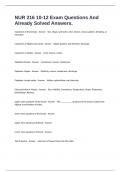NUR 216 10-12 Exam Questions And
Already Solved Answers.
Inspection of the breasts - Answer Size, shape, symmetry, color, lesions, venous pattern, dimpling, or
retraction
Inspection of Nipple and areola - Answer Nipple position and direction; discharge
Inspection of Axillae - Answer Color, lesions, rashes
Palpation:breasts - Answer Consistency, masses, tenderness
Palpation: Nipple - Answer Elasticity, masses, tenderness, discharge
Palpation: Lymph nodes - Answer Axillary, epitrochlear, and clavicular
Characteristics of Masses - Answer Size, Mobility, Consistency, Temperature, Shape, Tenderness,
Delimitation, Redness
upper outer quadrant of the breast - Answer The __________ quadrant of the breast contains the
highest concentration of lobes.
lower outer quadrant of the breast - Answer
Upper Inner Quadrant of Breast - Answer
Lower Inner Quadrant of Breast - Answer
Tail of Spence - Answer extension of breast tissue into the axilla
,vertical strip method - Answer Place the finger pads of my middle three fingers against the top outer
edge of the breast. Palpate downward, the upward working my way across the entire breast
Pie Wedge method - Answer
Concentric circles method - Answer
Lymphatic/hermatological relation to breast - Answer Ask about infection or malignancy
Lymph nodes: Enlarged lymph nodes may indicate infection or metastasis
Normal breast findings - Answer Breast lobular, symmetrical, color consistent with body color.
No masses, lessions, edema, dimpling, retraction or orange peel skin.
Breasts may normally be slightly asymmetrical.
Abnormal breast findings - Answer Change in breast symmetry: Warrants further investigation
Edmea and orange peel skin appearance: Lymphatic obstruction
Erythema: Infection, abscess, or inflammatory carcinoma of the breast
Dimpling or puckering: Sign of retraction phenomena or abnormal traction on Cooper ligaments- or
attachment to fascia and pectoralis muscle-caused by neoplasm
Normal Nipple and areola - Answer Nipples and areola symmetrical, round and darker than breast
tissue
, Color lighter in fair skinned and darker in dark skinned women. No masses, lesion sor discharge
Spontaneous discharge normal during pregnancy and lactation
Symmetrical nipple direction, usually lateral and upward. Nipples
May be everted, flat or inverted, but should be symmetrical
Abnormal nipple and areola finding - Answer Change in nipple from everted to inverted, or in the
direciton in which it is pointing: Underlying Mass
Flattened or inverted nipples: Shortening of mammory ducts
Spontaneuous discharge not associated with pregnancy or breast feeding warrants follow up
Lesions or erosion and ulceration of areola and nipple: Paget disease
Discoloration of areola and nipple that is not associated with pregnancy warrants follow up
Cracks and redness of nipple can occur with breast feeding
Normal axilla findings - Answer Skin intact, no lesions or rashes. Hair growth appropriate for patients
age and sex
The skin of the axillae should be smooth and intact with no areas of discoloration, edema, or rash
Axillae-Expected variations - Answer A client who has a history of a mastectomy may have
lymphedema due to the surgical procedure disrupting the normal pathways of lymph drainage from the
breast are




